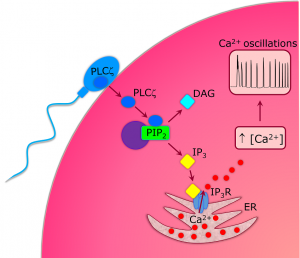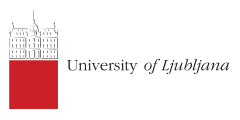Description
-
Structure-based protein thermodynamics
Protein stability is investigated using high-accuracy calorimetric and spectroscopic techniques. Experimental results and theoretical analyses pave the way for understanding protein folding. The role of environmental factors and mutations in protein stability is investigated, bearing direct implications upon controlling function. The thermodynamics of protein interactions with small peptides, other proteins, and ions are systematically explored in order to understand biological mechanisms as well as to optimize protein engineering designs.

Schematic representation of egg activation triggered by sperm-specific PLCζ
In the applied research front, protein interactions are investigated with polymers, dendrimers, liposomes, cyclodextrins and polymeric nanoparticles, in the context of multidisciplinary research programs aiming at the development of novel diagnostic and therapeutic carriers. Protein stability at very-high pressures is studied for selected molecules important in the food industry.
One of the most important collaborative and highly interdisciplinary programs, currently running in the Biomolecular Physics Lab refers to functional, biochemical and biophysical studies of PLC-zeta, the “sperm factor” and its association to male infertility as well as other calcium regulating proteins such as calmodulin.
Other projects include studies of chitinases, metal binding proteins and the BRCT domains of human BRCA1, BARD1 and 53BP1 proteins, where a systematic characterization of pathogenic variants linked to hereditary breast/ovarian cancer is pursued.
In the applied research front, protein interactions are investigated with polymers, dendrimers, liposomes, cyclodextrins and polymeric nanoparticles, in the context of multidisciplinary research programs aiming at the development of novel diagnostic and therapeutic carriers. Protein stability at very-high pressures is studied for selected molecules important in the food industry.
-
Nanoparticle-doped liquid-crystalline systems
Novel hybrid materials are developed by homogeneously dispersing nanoparticles in chiral liquid crystals. A wide variety of surface-functionalized nanoparticles is designed of various shapes and sizes. Spherical quantum dots and gold nanoparticles as well as nano-platelets, rods, tubes and decorated graphene sheets are employed.
By exploiting nanoparticle interactions with topological lattice defects, mechanical and optoelectronic properties, important to the display and sensor industries, can be extended to new extremes. Systematic experimental and theoretical studies are carried out investigating how liquid-crystal phases with novel molecular organization can be stabilized. The complexity and quenched random disorder exhibited by the new hybrid systems is explored in phase transitions, order-disorder and critical phenomena.
Controlled nanoparticle self-assembly is achieved by capitalizing upon phase separation effects in the highly anisotropic liquid-crystalline medium. Exotic three-dimensional superstructures are obtained at interfaces and defect-rich regions, exceeding well over 100-micron distances.
-
Characterisation of drug delivery systems
In vitro studies of the controlled release of active substances from nanoparticles and nanocomposite matrices for different therapeutic applications.
Media Gallery of Biomolecular Physics Laboratory
People
Infrastructures
Latest Grants
Proud to Collaborate with

United Kingdom

Qatar

Greece

Finland

Greece

Greece

Greece

Greece

Slovenia

Slovenia

Belgium

Greece

Greece






